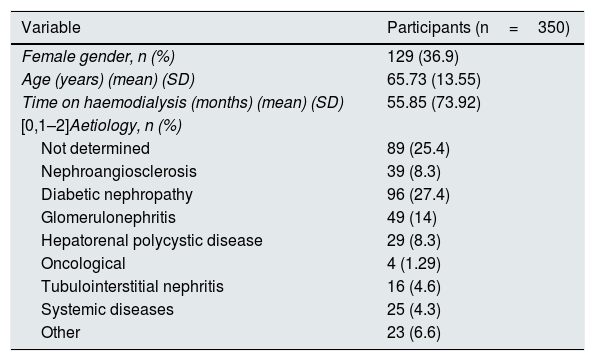Infection by SARS-CoV-2 currently continues to pose a threat to global public health. Our Autonomous Community of the Canary Islands presented between 108–135 new cases/day during the peak of the pandemic (between 23 and 27 March, 2020).1 The population of haemodialysis patients is especially vulnerable given their specific characteristics.2 For these reasons, our hospital and its satellite dialysis centres established their own biosafety protocol in accordance with national and regional guidelines.
Once the peak of the disease had passed (106 days later), it was decided to do a cross-sectional screening with SARS-CoV-2 RNA PCR, using the transcription-mediated amplification technique and total antibodies using the enzyme-linked immunosorbent assay (ELISA) in our population (n=350) with the aim of determining the repercussions of the disease in terms of asymptomatic and/or past infection. Demographic data were collected from electronic records and are detailed in Table 1.
Baseline characteristics of the population.
| Variable | Participants (n=350) |
|---|---|
| Female gender, n (%) | 129 (36.9) |
| Age (years) (mean) (SD) | 65.73 (13.55) |
| Time on haemodialysis (months) (mean) (SD) | 55.85 (73.92) |
| [0,1–2]Aetiology, n (%) | |
| Not determined | 89 (25.4) |
| Nephroangiosclerosis | 39 (8.3) |
| Diabetic nephropathy | 96 (27.4) |
| Glomerulonephritis | 49 (14) |
| Hepatorenal polycystic disease | 29 (8.3) |
| Oncological | 4 (1.29) |
| Tubulointerstitial nephritis | 16 (4.6) |
| Systemic diseases | 25 (4.3) |
| Other | 23 (6.6) |
A 36.9% were female, the mean age was 65±13.55 years, 48.6% had type 2 diabetes mellitus as the principal comorbidity and 94% had arterial hypertension. The main causes of kidney disease were: diabetic nephropathy (27.4%) and unknown (25.4%).
The result showed that no patient tested positive in the SARS-CoV-2 RNA PCR and all were negative for total antibodies.
The importance of SARS-CoV-2 screening has been discussed recently by some authors.3 Since haemodialysis patients are especially vulnerable due to their clinical and logistical characteristics (for example, their need to go to the hospital an average of three to four times a week), we consider that the screening of both the population and the personnel who care for them is fundamental.
The results obtained in our series may be due to four causes: 1) the low prevalence of the disease during the peak of the pandemic in the northern area of the island of Gran Canaria1; 2) since the time for preparation was longer than in other provinces, protocols were established for both physical distancing and strict clinical control (for example, use of masks by all patients, limitation of visits, temperature measurement before entry into the units, etc.)4; 3) the measurement of antibodies was conducted late,5 and 4) the political measures were adopted early, such as the closure of schools, airports and harbors, among others.6
Please cite this article as: Valga F, Monzón T, Vega-Diaz N, Antón-Perez G, Rodriguez-Perez JC. Cribado de SARS-CoV-2 de pacientes en hemodiálisis crónica en un hospital de tercer nivel y sus centros periféricos: una hora menos en Canarias. Nefrologia. 2021;41:470–471.






